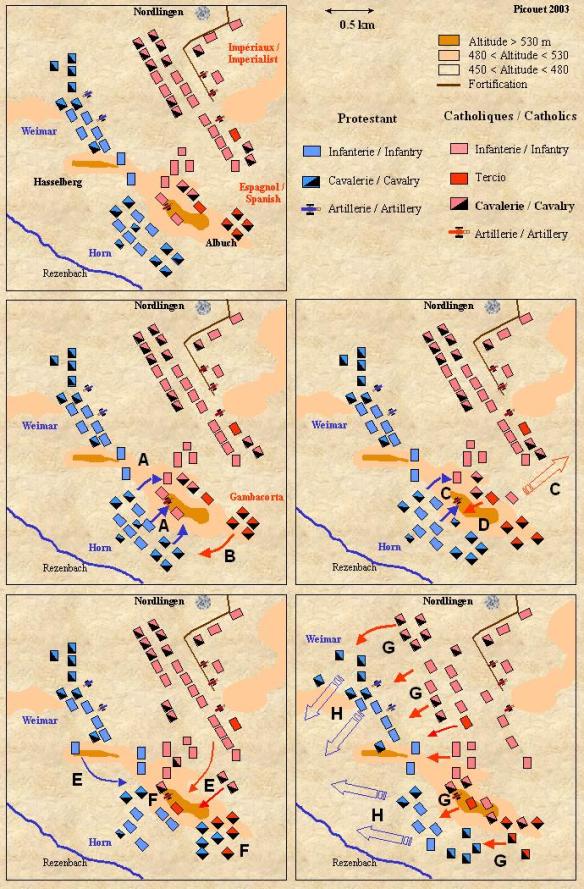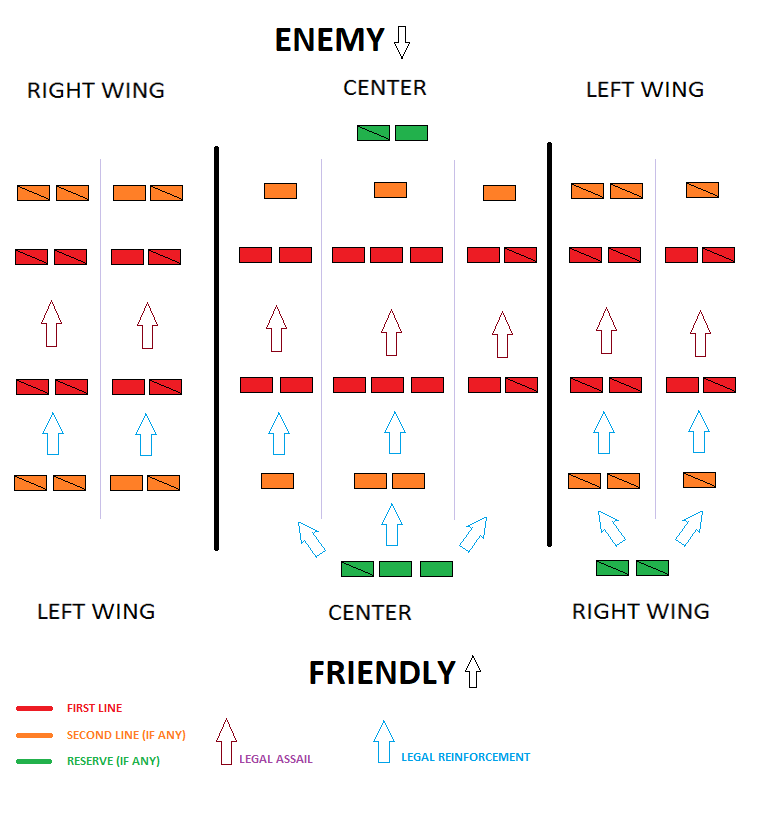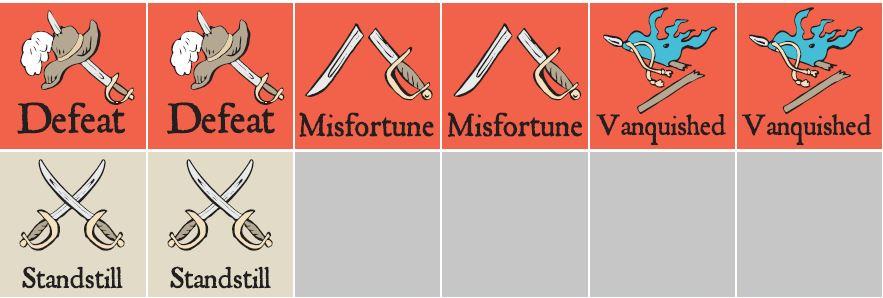PIKES LEVEL!
WHAT LOOKS MORE LIKE A BATTLE - A WARGAME TABLE, OR A DIORAMA?
That's easy. It's the diorama. Why is that? Simple- the diorama, not constrained by the needs of wargamers to keep track of details required to play a game, can show terrain and soldiers placed realistically to represent a moment in the battle.
Battle of Lutter 1626 - Diorama in the Goslar Museum
BUT DOESN'T THE END OF EACH TURN IN A GAME REPRESENT A MOMENT IN TIME?
Actually it does, but unfortunately it can't look like a diorama. Regiments need to be positioned in space and time to show how far away the are from an enemy; are they in charge reach? Are they in range of enemy musketeers? Are they partially touching that terrain piece, and thus disordered? Can the whole regiment fire at that enemy regiment, even though some of the figures are not in a 22.5 degree arc? Is that enemy horse regiment capable of launching a flank charge, seeing as slightly less than half of it is behind an imaginary line stretching from its target?
EVEN THE ACTUAL FIGHTING ISN'T LIKE A REAL BATTLE
At Nordlingen in 1634, Horn's swedes charged the Catholic position on Allbuch hill a dozen times. Ever seen that on the tabletop?
It would be almost impossible to model. You would have to maneuver your regiments up to the place, get repulsed (fall back 6"?) then try and maneuver and wheel around other regiments individually falling back or advancing. It would be extremely time consuming so rules writers make designers notes stating that each attack can represent a few actual charges. This is usually unsatisfying, since you don't get the 'look' of a real battle.
LET'S FACE IT, WE HAVE TO LIVE WITH SOME UNREALISTIC ABSURDITIES TO PLAY GAMES
Terrain is usually square-ish or linear. It has to be so we can fit regiments into places that are not 'gray-areas' that an opponent might object to, where it may be curved around a bend in a stream, or be half inside-half outside a wall or building. Forests are large, clumps of trees may look more realistic but are hard to model in any rules. Anything that is not easy to represent makes players feel uneasy about using, like a bridge that two regiments may be fighting over, or
the inside of a walled park. Geometry is not your friend on the tabletop, because the angles rarely line up.
Really hard to simulate - "Units must stay at least two inches from an enemy unless in hand-to-hand combat...."
A NEW WAY TO PLAY OUT MINIATURES BATTLES?
Maybe! We're not quite sure...
WHAT IF THERE WAS A WAY TO GET THE EXCITEMENT OF A GAME, AND THE LOOK OF A DIORAMA, THAT PLAYED HISTORICALLY?
GULP! That's what we're claiming PIKES LEVEL! actually does. It may not be true, it may be heresy, but that's our claim. We think we came up with an idea that leaves you with all the critical decisions that decisive battles are all about, without being shackled to rules that are all about tiny details of facing, ranges, remembering how to depict a routing unit, etc, leaving you to focus on actually planning for victory instead of finding ways to use rulers to give you an advantage in the next fire phase...!
REPRESENTING WHAT WARGAMERS REALLY WANT TO RESPRESENT
In PIKES LEVEL! players will fight battles as if you're looking at a broadsheet for the Thirty Years War. On a single sheet they would represent the key points of the battle: the skirmishing, to the main attacks, the crisis, and then the flight of one side. PIKES LEVEL! is about organizing large or small attacks (or diversions), reinforcing them and following up to break the enemy line, or as the defender, throwing the enemy back by sudden counter-attacks even when the position looks lost. Movement of reserves and second lines are what brings victory or saves you from utter defeat.
SO HOW IS IT DIFFERENT FROM OTHER RULES?
There are no movement rates in PIKES LEVEL! There are no hexes or squares. There are no firing arcs or ranges. You don't move from terrain piece to terrain piece. There's no rule for wheeling, turning to face, or backing up. There are no rules for movement slowing through disordering terrain. No road movement, how to form column. Yet all these concepts are represented in the diorama aspect of the rules.
OK, LET'S SEE HOW IT WORKS
STEP ONE - ORGANIZING YOUR ARMY
You only get one shot at this, so do it wrong and you lose. You start the game with a number of Regiments and Guns in the form of counters, each representing a unit of miniatures on the tabletop. These are then placed on your display as shown in the example of a small army below. There are limits to the number of regiments in a Wing (Left, Center, Right), a Line (First or Second), and a Division, but generally players can do as they please, even not having a second line or reserve if you don't want to (but you will almost certainly lose if you don't).
If you want to win, you will need to plan your attacks, diversions and defenses as you place the counters- think ahead! Regiments generally move forwards in this game, not side to side, so act accordingly. Of course the scenario will tell you about the terrain in your setup area as well as your opponent's, as this will have an important effect on combat.
Once both sides have placed their counters (hidden from eachother), you can place the miniatures on the tabletop. No going back now!
Here's another example showing a different army, and depicting allowable movement.
The battle of Nordlingen, 1634
STEP TWO - START PLAYING!
The Active player (who initiated the battle) chooses a wing to start their 'Assails', sort of like an operation. They pick a Division to attack an enemy Division directly opposite, like a lane of sorts. They can then attack with another Division or not attack at all, and pass to the other player, who does the same. Then the Active player proceeds to the next Wing and so on until all of the Assails are declared.
STEP FOUR - RESOLVE BATTLES!
There are no combat charts. Engagements are resolved by picking a chit from a cup. For example, I had some Professional foot attacking some not-so-great regiments in a strong enclosure and a hill. Since it was in the center, we automatically place a red (attacker) defeat, blue (defender) defeat, and a standstill in the cup. Since I was double the enemy's strength we place a blue mischance chit, and a blue vanquished chit. Then we placed a red mischance because of his terrain and drew for the result. There are only seven different chits possible, so it takes seconds.
STEP THREE - 'MOVE' YOUR MINIS
ASPECT is a word used in the rules for positioning your troops. Now you enter the Diorama part of the game. The Assailing player simply PLACES the regiments in the Assailing Division to look like they are attacking their opposite numbers, any way they feel like so it looks like a narration of a battle. So you can show them spreading a few skirmishing commanded shot in front of them while trying to turn a flank. Then the defender places his regiments to receive them. It's sort of like by mutual consent... DON'T PANIC, hear me out.
And so on for all the Assails.
The Captain after releasing these rules
Let's say I drew a blue defeat Chit. That means the defender is defeated. All his regiments are counted as 'Roughly Handled' and fight less effectively from now on. ASPECT time! Show the defenders in a bit of trouble, falling back a bit. Show some attackers breaking into their position slightly- next turn they count as 'In Amongst Them' and get an extra chit. But wait- the defenders immediately try a Counter-Assail, and bring a regiment from their second line
into the first for added strength. If they win, show them pushing the enemy out of their position, or if they win big, Vanquishing them and sending them into headlong rout (never to return). Now rearrange the figures and that act is closed until next turn.
STEP FIVE - REORGANIZE!
At the beginning of the next turn, both players make decisions- should I bring forward some of my precious reserves to exploit the success, or hang onto them for an emergency? Should I use my second line to reinforce the first so I can attack or face his large division opposite? Well, if you want to, simply place them there.... most historical battles have 'phases' rather than continuous action, so there are lulls where both sides make changes. This is represented in these rules.

CONVINCED? MAYBE NOT, BUT THAT'S OK
The rules have plenty of other chrome we haven't mentioned, like successful Horse breaking into the Center Wing from the flanks, advantages for Light Horse, Dragoons, Commanded Shot....
did I mention the rules are only 9 pages?
Well, so far, and we mean to keep them as small as possible.
PLAYTESTERS WANTED!!!!
Quite honestly these rules have not been extensively tested. If you'd like to try them out and give us your opinion and some comments, download them and give them a go.
Rules for the Thirty Year's War and the English Civil War
From weaponsandwarfare.com
You can contact us by email HERE.
Here's the full zip:
In case of difficulty unzipping, here are the individual files:









